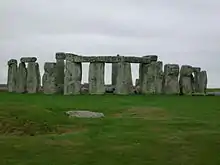Ancient monument
In British law, an ancient monument is an early historical structure or monument (e.g. an archaeological site) worthy of preservation and study due to archaeological or heritage interest. The term differs from the American term "national monument" in that U.S. National Monuments are comparatively few in number and may include natural formations; British ancient monuments are by definition manmade.

Stonehenge is one of the most famous prehistoric ancient monuments.
Ancient monuments are defined by the Ancient Monuments and Archaeological Areas Act 1979[1] as
- (a) any scheduled monument (of which there are currently more than 20,000[2]); and
- (b) any other monument which in the opinion of the Secretary of State is of public interest by reason of the historic, architectural, traditional, artistic or archaeological interest attaching to it.
References
- "Ancient Monuments and Archaeological Areas Act 1979". 4 April 1979. Retrieved 28 February 2012.
- "Scheduled Monuments" (PDF). Department for Culture, Media and Sport. March 2010. Archived from the original (PDF) on 2012-12-04. Retrieved 7 June 2011.
External links
This article is issued from Wikipedia. The text is licensed under Creative Commons - Attribution - Sharealike. Additional terms may apply for the media files.